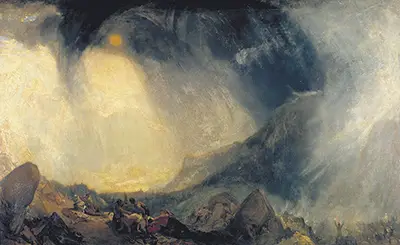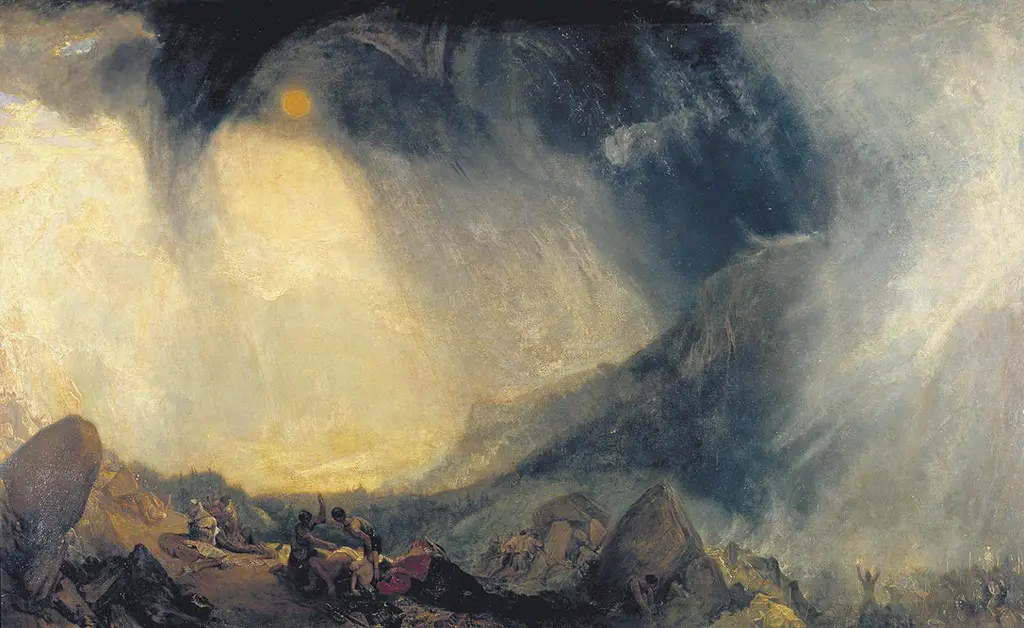 Buy Art Prints Now
Buy Art Prints Nowfrom Amazon
* As an Amazon Associate, and partner with Google Adsense and Ezoic, I earn from qualifying purchases.
JMW Turner completed a number of powerful scenes based on snow storms, where he allowed himself to fully immerse himself in the romantic nature of his artistic style.
This painting underlines the vulnerability of humanity when faced with the true force of nature. He would often use small figures to depict humans or animals within his sprawling landscape scenes but in this case they serve a greater purpose than merely aiding perspective - their position of peril builds an additional layer of intensity for the viewer. The army is making a dangerous journey against the will of nature and we find them placed in the nearest foreground, some on a raised hill, and others further to the right, appearing to be in a combination of shock and excitement by the approaching storm.
There is a rocky landscape featured alongside the human figures whilst the rest of the composition is devoted purely to nature, with the powerful storm creating a frenzy of chaos which would have been a terrifying experience for those caught up in it. We are looking at members of the Carthaginian army, whose leader was Hannibal Barca, though he is not actually depicted specifically within the painting. He was a formidable leader with a reputation for success and ruthleness, but even his army here is left fairly powerless as the storm passes through. Perhaps that is the reason for Turner to choose him specifically, where even the fiercest warriors are powerless against the relentless power of nature.
The artwork was unveiled at the Royal Academy Summer Exhibition of 1812, which, that year, was actually held at Somerset House. The catalogue which accompanied the show laid out the image of this painting with some extra detail as well as some poetry from the artist himself. He would often marry literature and art together, sometimes even writing passages specifically to sit alongside some of his paintings. His writings were as follows:
Craft, treachery, and fraud – Salassian force,
Hung on the fainting rear! then Plunder seiz'd
The victor and the captive, – Saguntum's spoil,
Alike, became their prey; still the chief advanc'd,
Look'd on the sun with hope; – low, broad, and wan;
While the fierce archer of the downward year
Stains Italy's blanch'd barrier with storms.
In vain each pass, ensanguin'd deep with dead,
Or rocky fragments, wide destruction roll'd.
Still on Campania's fertile plains – he thought,
But the loud breeze sob'd, "Capua's joys beware!"
The scene that we find here is of soldiers attempting to cross the Maritime Alps in 218 BC. In addition to the natural forces that had taken up against them, there were also other tribes in the vicinity who were not happy about their arrival. The piece itself measures nearly two and a half metres wide, making it a very large painting, but in keeping with some of the more ambitious works produced by Turner. It is actually the first storm from his career, where wind and rain create a circular motion of frightening madness. It also allowed him an opportunity to play with lighting with an expressive freedom that was one of his main strengths as an artist. He would later repeat these displays of nature's power in several later works. This composition itself features a bright, but small, sun peaking through in the far distance, whilst a curved black mass of cloud starts to engulf all that stands in its way.





